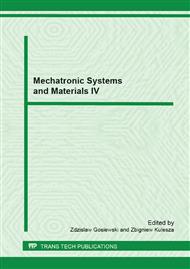[1]
A. Preumont, Vibration Control of Active Structures an Introduction, Kluwer Academic Publishers, London, (2002).
Google Scholar
[2]
I. Maciejewski, L. Meyer, T. Krzyżyński, Modelling and multi-criteria optimisation of passive seat suspension vibro-isolating properties, Journal of Sound and Vibration 324 (2009), 520-538.
DOI: 10.1016/j.jsv.2009.02.021
Google Scholar
[3]
G.J. Stein, P. Múčka, T.P. Gunston, S. Badura, Modelling and simulation of locomotive driver's seat vertical suspension vibration isolation system, International Journal of Industrial Ergonomics, Vol. 38, Nos. 5-6 (2008), 384-395.
DOI: 10.1016/j.ergon.2007.08.007
Google Scholar
[4]
G.J. Stein, P. Múčka, T.P. Gunston, A study of locomotive driver's seat vertical suspension system with adjustable damper, Vehicle System Dynamics Vol. 47 No. 3 (2009), 363-386.
DOI: 10.1080/00423110802148920
Google Scholar
[5]
R. Alkhatiba, G. Nakhaie Jazarb, M.F. Golnaraghi, Optimal design of passive linear suspension using genetic algorithm, Journal of Sound and Vibration 275 (2004), 665-691.
DOI: 10.1016/j.jsv.2003.07.007
Google Scholar
[6]
J.S. Bendat, A.G. Piersol, Random data: Analysis and measurement procedures, Wiley-interscience a division of John Wiley&Sons, (1971).
DOI: 10.1177/058310249202400503
Google Scholar
[7]
British Standards Institusion BS EN 13490, Mechanical vibration - Industrial trucks - Laboratory evaluation and specification of operator seat vibration, London (2002).
DOI: 10.3403/02473628u
Google Scholar
[8]
International Organization for Standarization, Agricultural wheeled tractors - Operator's seat - Laboratory measurement of transmitted vibration, ISO 5007, Genewa (2003).
DOI: 10.3403/02802607
Google Scholar
[9]
International Organization for Standarization, Earth-moving machinery - Laboratory evaluation of operator seat vibration, ISO 7096, Genewa (2000).
Google Scholar
[10]
M.J. Griffin, Handbook of Human Vibration. Elsevier Academic Press, London (1996).
Google Scholar
[11]
International Organization for Standarization, Mechanical vibration and shock - Evolution of human exposure to whole body vibration, ISO 2631, Genewa (1997).
Google Scholar
[12]
I. Maciejewski, T. Kiczkowiak, T. Krzyżyński, Application of the Pareto-optimal approach for selecting dynamic characteristics of seat suspension systems, Vehicle System Dynamics Vol. 49 No. 12 (2011), 1929-(1950).
DOI: 10.1080/00423114.2011.560270
Google Scholar


